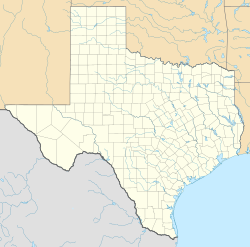Top Qs
Timeline
Chat
Perspective
Dinosaur Valley State Park
State park in Texas, United States From Wikipedia, the free encyclopedia
Remove ads
Dinosaur Valley State Park is a state park near Glen Rose, Texas, United States known for having 113 million-year-old well-preserved theropod and sauropod footprints across five main tracks throughout the 1.52k-acre park.[2][3] The tracks were formed along the coast line of what was a vast inland sea, when these dinosaurs stuck their feet into fine-grained limy soft mud, their footprints were perfectly preserved.[4] In 1909, the area was uncovered when a child discovered "large, three-toed tracks" along the river following a flood on the Paluxy River a year earlier. Around 1928, upon becoming aware of the site, paleontologist R.T. Bird of the American Museum of Natural History in New York, visited the area and discovered sauropod tracks, which was "the first proof that sauropods walked on land."[5] Of note, some tracks were believed to be made by humans and sparked the idea by young-earth creationists that dinosaurs and humans once roamed earth together.[6] The park is known for having two large sculptures of a Tyrannosaurus and a Brontosaurus, created and donated by the Sinclair Oil Corporation.[7]
Remove ads
History
Dinosaur Valley State Park, located just northwest of Glen Rose in Somervell County, Texas, is a 1,524.72-acre (617 ha) scenic park set astride the Paluxy River. The land for the park was acquired from private owners under the State Parks Bonds Program during 1968 and opened to the public in 1972.[8] In addition to being a state park, it is also a National Natural Landmark.[9]
Eastward-dipping limestones, sandstones, and mudstones of the Glen Rose Formation were deposited during the early Cretaceous Period approximately 113 million years ago along the shorelines of an ancient sea, and form the geological setting for the park area. Over the last million years or so, these layered formations have been eroded, dissected and sculpted by the Paluxy River which, in many places, has cut down to resistant beds and planed off sizable exposures of rock in the river bottom.[8]
Remove ads
Controversy
Summarize
Perspective
Near Dinosaur Valley State Park, in the limestone deposits along the Paluxy River, "twin sets" of tracks were found in the Glen Rose Formation as early as 1908. These footprints were once thought to be evidence that humans and non-avian dinosaurs lived at the same time, but now are identified to be created by dinosaurs.[6] However, young-Earth creationists continue to believe that humans and non-avian dinosaurs lived at the same time, a notion that is contrary to the standard view of the geological time scale. Biologist Massimo Pigliucci has noted that geologists in the 1980s "clearly demonstrated that no human being left those prints," but rather "they were in fact metatarsal dinosaur tracks, together with a few pure and simple fakes."[10]
The family of George Adams, who claimed to have found human footprints in the Glen Rose Formation, later admitted that Adams' and some others' fossil footprints were a hoax.[11] Zana Douglas, the granddaughter of George Adams, explained that during the 1930s' Great Depression her grandfather and other residents of Glen Rose made money by making moonshine and selling "dinosaur fossils".[11] The faux fossils brought $15 to $30 and when the supply ran low, they "just carved more, some with human footprints thrown in."[11]
Remove ads
See also
References
External links
Wikiwand - on
Seamless Wikipedia browsing. On steroids.
Remove ads


